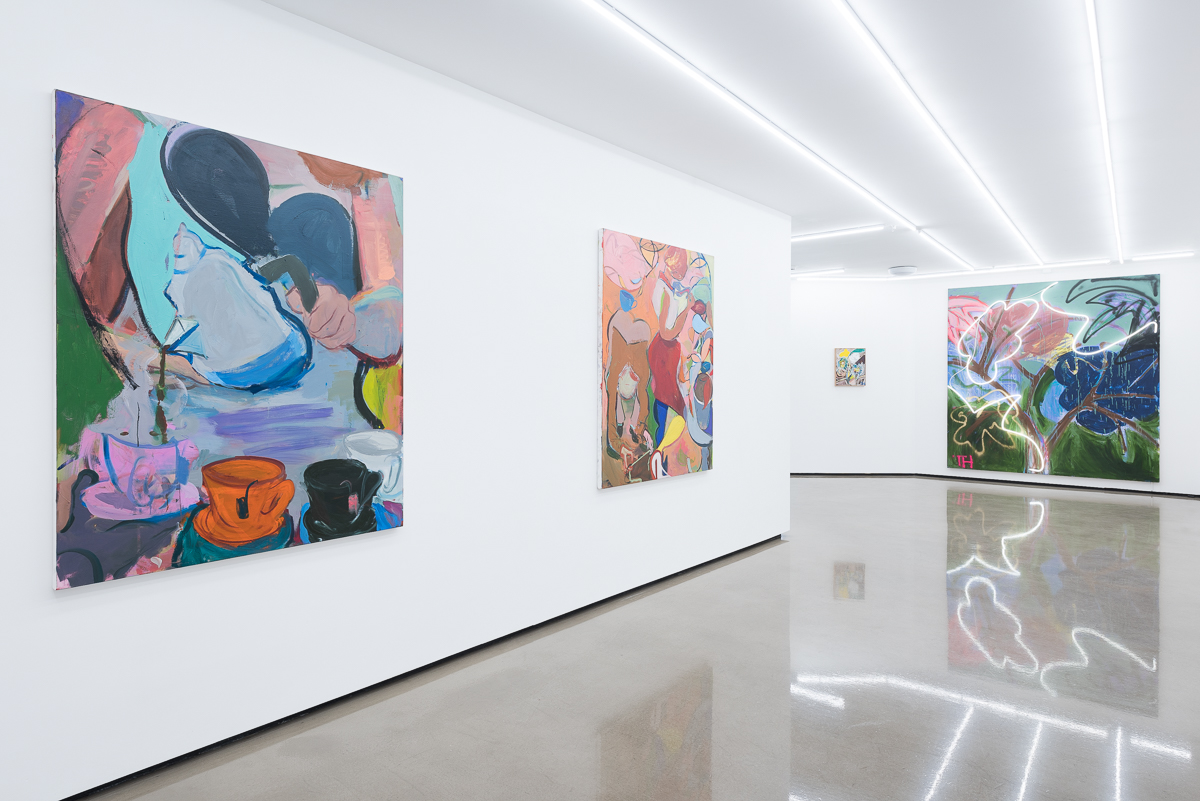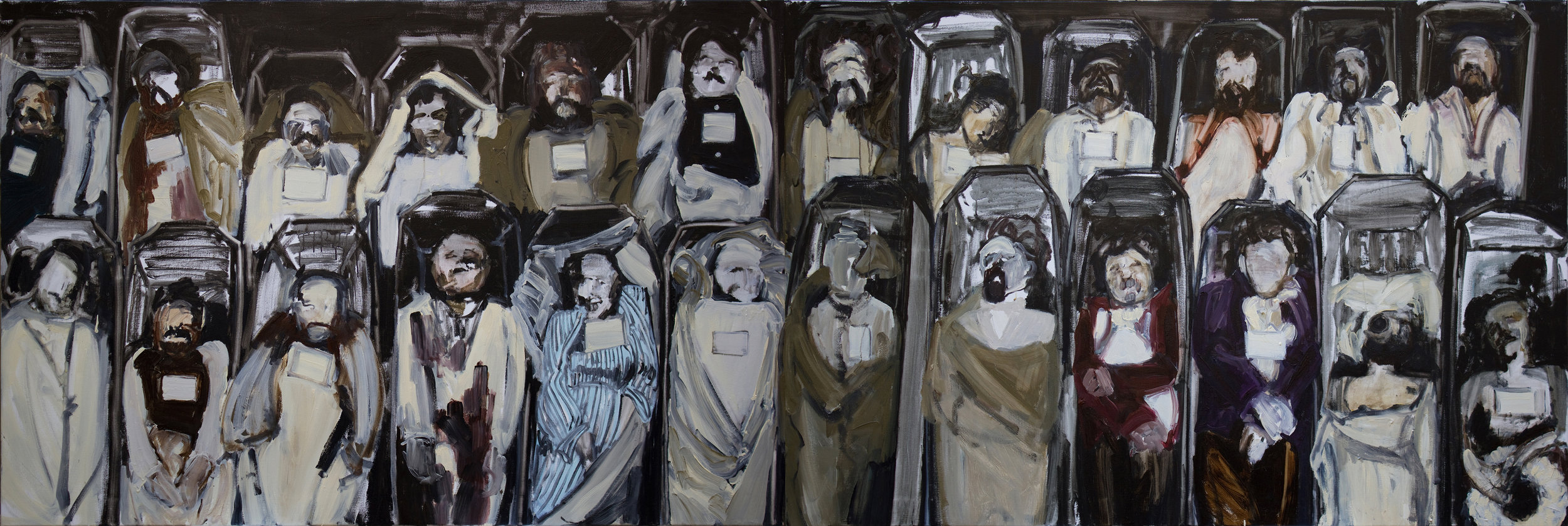Hugh Mendes

"these series of obituaries are never ending. In a way, my own obituary is the logical conclusion."
Could you tell us a bit about yourself. How long have you been a practicing artist and where did you study?
I seem to have been at it most of my life. Perhaps from the age of about six I thought I would be an artist. I studied painting (BA) at Chelsea Art School, in the old days pre UAL when it was a small independent art school on Manresa Rd. Staff included David Hockney, Euan Uglow and Craigie Aichison. I learned a lot from all of them, mostly in the 'life room'. I then had a long break from academia before studying for my MA at City & Guilds of London Art School, where I continue to teach. This return to a full time practice and an academic environment was triggered by the death of my father.
I had been a practicing Buddhist during the intervening years, much of it spent living and teaching in San Francisco. This all contributed to a new and very focused approach to painting. Also to working with Still Life, in the sense of Vanitas. It was on my MA that I started using newspaper clippings with other objects to create small still life paintings. Like a lot of artists, I had lots of images and clippings on my studio walls. Paul Hedge from Hales Gallery came into the studio one day and casually asked if I had ever tried to paint one of the newspaper clippings. I thought it would be too hard, but it was a challenge and the rest is history as they say... just a casual remark!
Obituary: Margaret Thatcher, 2014
Obituary: Alexander McQueen, 2010
You are recognised for your ongoing/obsessional series of obituary paintings, could you tell us how this series started? And where do you see it going in the future?
Having begun working with newspaper clippings, especially with the 9/11 series following my graduation on that day in 2001, it was a couple of years later that I became interested in the Obituary pages of The Independent (now itself sadly deceased). I began a correspondence with the obituary editor at the time, James Fergusson. He was using some unusual images, which intrigued me... Over time they became quite dominant within my practice, though I do still work with other subjects such as war, terrorism and to a lesser extent politics. It was interesting that the obituary paintings seemed the most popular, were exhibited internationally, especially in the USA, and sold well. At some point I started using The Guardian more for my source material and have maintained a correspondence with them; a kind of intermittent dialogue.
As to the future, one is never quite sure. My current series has become focused on Obituaries of Artists. Of course these series of obituaries are never ending. In a way, my own obituary is the logical conclusion. Goya managed a fantastic final painting of himself dying in the arms of his doctor! It is in the New York Met, but was in London recently...
I was on an art residency this summer in northern California and executed a specific proposal to paint objects from the land there, like rocks and sticks. It was interesting to engage with a somewhat different 'one off' project. Though still with the overall context of Still Life and the 'found' object. The paintings were more table based than wall based, though there was also a reference to a wall in most of the paintings.... not so different to the newspaper based paintings really!
Obituary: Anthony Caro, 2016
Obituary: Lucian Freud, 2016
Obituary: Robert Raushenberg, 2016
Your paintings of newspaper clippings are effectively: A picture within a picture as a picture. Could you tell us the thoughts behind this? Does it also question the ownership of images?
Yes. This has been quite well written about by Frances Woodley in her recent article about my work, to accompany the show. Also the title of the forthcoming show refers to this, referencing Barthes 'The Death of the Author', questioning the notion of 'authorship', etc. Being from a newspaper, they are in the public domain. I buy that piece of paper and own it. In painting it of course I create a one off original object.
There is an interesting and current debate around copyright, that I have been following. Luc Tuymans recently fell foul of this in the courts. Richard Prince actually had to destroy some of his works. As far as I am concerned everything is up for grabs. I guess this is a kind of 'postmodern' position. The first part of your question is answered within the history, and contemporary context, of Still Life painting. There is an element of Trompe L'oile, as well as Vanitas, etc. I continue to study and teach this subject. I am always looking and questioning, thinking and experimenting and it helps to be employed within a very good academic environment.
Obituary: David Weiss, 2016
Obituary: Ellsworth Kelly, 2016
As well as Obituaries you also paint about world events, notably: the 9/11 terrorist attack. In 2011 you had a show (to mark the 10th anniversary) with a series of works based upon the newspaper clippings of that day and the years after. As an artist was this a tough subject to tackle?
I was glued to it on my graduation day in 2001. My first solo show was a few months later, titled 'Into Manhattan's Memory' and featured about 20 paintings of images from the immediate aftermath of 9/11. I then followed the story into the 'War on Terror', the invasion of Iraq, and so on. So I had been painting these images for the entire 10 year period. It was good to have that 10 year anniversary show. It was neatly concluded with the killing of Osama Bin Laden, just before the anniversary, so I included his obituary painting in the show. Also included in the show was some original news footage of the events as they unfolded. As soon as I turned on the telly that day and saw the second plane fly into the twin towers, I started video taping. I still have that tape. The footage follows on from an episode of 'The Simpsons' that I had recorded the night before. It is a somewhat extraordinary juxtaposition! Of course an element of Still Life is juxtaposition (of objects).
The anniversary show, titled 9/10/11 was hosted by Kenny Schachter in his London gallery. He was living in New York on the day and witnessed everything with his young kids.
Yes it is a difficult subject and I had some flack with my first solo show. Some people found it shocking, disrespectful; one far right American magazine even accused me of promoting terrorism, etc. Ten years later, it was more acceptable perhaps and I was interviewed on Radio 2 and featured in The Independent, etc...
In the run up to the show I thought I should do a special piece, something a bit unusual, respectful, meditative... I made a piece called 3000 names. In 'The Times' obituary of Osama Bin Laden, they listed all 3000 names of the people that died on that day, alphabetically. I worked out that if I copied and wrote out all the names, as an obituary piece, at an average of 75 names per day for 6 weeks I could do it. So that is what I did. I had a Pentel automatic pencil, which I was worried would run out of lead before I finished. However as I wrote out the last name, the tiny stub just dropped out. It was a beautiful moment. That piece, on three A3 pieces of paper now resides in the Nobel collection in Zurich. The entire collection is based on newspapers in art, from the beginning of the 20th century, and includes Schwitters, Warhol, Rauschenberg, etc.
Obituary: Osama Bin Laden, 2011
3000 Names, 2011
Tell us a bit about how you spend your day/studio routine? What is your studio like?
It is a good size and is full of paintings and newspapers, not surprisingly. It is quite well ordered, has a good big window, so lots of natural light, which is important to paint by.
I start the morning with a coffee and The Guardian. The first thing I look at of course is the Obituary page... who died? I will meanwhile be looking from the couch at whatever painting in on the easel. I will usually make immediate corrections or adjustments. They jump out at me as soon as I enter the studio. I will also be checking e mails, of course. Being self employed means I function a lot through this medium... Here I am in the studio at my desk, writing on the computer!
I will usually spend about 6 hours on a good studio day painting. It is a slow process, meticulous, with a lot of attention to detail. I teach two days per week, so have up to five for painting, though I like to spend weekends with my wife and socialising as well as going to shows...
What do you hope the viewer gains/reacts from looking at your work?
I have mentioned a few responses above (to the 9/11 works). I hope people will just look and perhaps see. They are meditative paintings. Perhaps contemplative. This is an aspect of Still Life. A viewer might consider their own mortality. Of course this can be challenging. In the Obituary series, it is perhaps a chance to reflect on that particular persons life and the relationship the viewer has to that life. In the case of the Artist Obituaries of course that includes the body of their work and their contribution to our human history, etc. They are memorial pieces and that is part of their function.
I also hope that a viewer will just appreciate the paint on a surface. They are very much paintings and function within the history of painting and art generally, not just Still Life. I hope they have their place and can be appreciated as such. I really try by best with every one to make a beautiful painting/ object.
Obituary: Chantal Akerman, 2016
What artwork have you seen recently that has resonated with you?
I just saw the Richard Serra drawings on the opening day, at Gagosian. They are quite extraordinary and are a good example of why an artwork really has to be seen in 'the flesh'. They are black and have a beautiful quality of texture and surface in particular.
What does the future hold for you as an artist? Is there anything new and exciting in the pipeline you would like to tell us about?
Well I have this show 'The Death of the Artist' coming right up. It feels significant, like all my work has lead up to these artist obituaries. They are a logical conclusion in a way, of my practice. I am the next dead artist. Without being too morbid, it is symbolic. I paint my inevitable demise with every brush stroke!
It is also my first solo as a represented artist with CHARLIE SMITH LONDON. This feels significant. I still have an ongoing relationship with California and the art scene there. This show was originally going to open in LA, and I still hope it will go there next year in some form or other...
Meanwhile, Paint, Paint, Paint....
Interview published: 30/09/16




